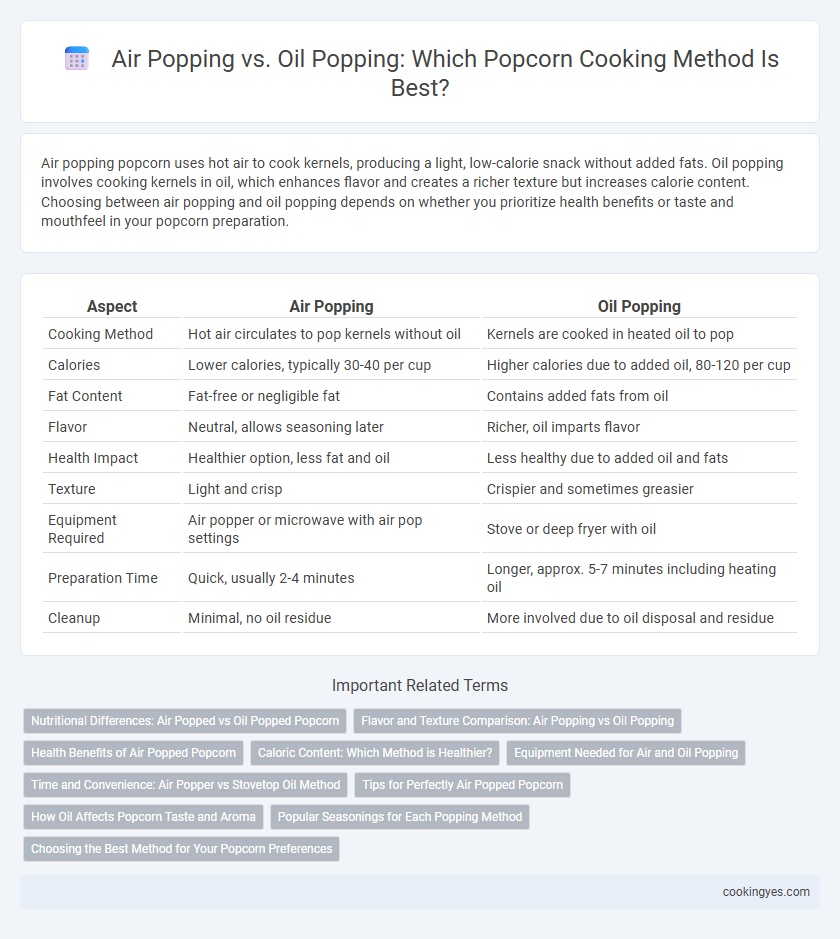Air popping popcorn uses hot air to cook kernels, producing a light, low-calorie snack without added fats. Oil popping involves cooking kernels in oil, which enhances flavor and creates a richer texture but increases calorie content. Choosing between air popping and oil popping depends on whether you prioritize health benefits or taste and mouthfeel in your popcorn preparation.
Table of Comparison
| Aspect | Air Popping | Oil Popping |
|---|---|---|
| Cooking Method | Hot air circulates to pop kernels without oil | Kernels are cooked in heated oil to pop |
| Calories | Lower calories, typically 30-40 per cup | Higher calories due to added oil, 80-120 per cup |
| Fat Content | Fat-free or negligible fat | Contains added fats from oil |
| Flavor | Neutral, allows seasoning later | Richer, oil imparts flavor |
| Health Impact | Healthier option, less fat and oil | Less healthy due to added oil and fats |
| Texture | Light and crisp | Crispier and sometimes greasier |
| Equipment Required | Air popper or microwave with air pop settings | Stove or deep fryer with oil |
| Preparation Time | Quick, usually 2-4 minutes | Longer, approx. 5-7 minutes including heating oil |
| Cleanup | Minimal, no oil residue | More involved due to oil disposal and residue |
Nutritional Differences: Air Popped vs Oil Popped Popcorn
Air popped popcorn contains significantly fewer calories and less fat compared to oil popped popcorn, making it a healthier choice for weight management. Oil popped popcorn absorbs the cooking oil, increasing its fat content and calorie density while potentially adding vitamins if healthy oils are used. The nutritional profile of air popped popcorn preserves its natural fiber and antioxidants without the added fats, supporting better heart health and lower cholesterol levels.
Flavor and Texture Comparison: Air Popping vs Oil Popping
Air popping popcorn results in a lighter, less greasy texture with a pure corn flavor, ideal for those seeking a low-calorie snack. Oil popping infuses kernels with rich, buttery taste and produces a crispier, more indulgent crunch due to the fat's heat conduction. Flavor intensity and mouthfeel vary significantly between the two methods, influencing consumer preference based on health considerations and taste.
Health Benefits of Air Popped Popcorn
Air popped popcorn offers significant health benefits by eliminating the need for oil, resulting in a low-calorie, fat-free snack rich in fiber and antioxidants. This method preserves vital nutrients while reducing the risk of heart disease and obesity compared to oil-popped options that add extra saturated fats and calories. Consuming air popped popcorn supports weight management and promotes digestive health without compromising on taste or texture.
Caloric Content: Which Method is Healthier?
Air popping popcorn results in significantly fewer calories compared to oil popping, with air-popped popcorn containing about 30 calories per cup versus oil-popped at roughly 55 calories per cup. The absence of added fats in air popping reduces overall caloric intake, making it a healthier option for weight management. Oil popping increases calorie density due to the absorption of cooking oils, which can also introduce unhealthy fats depending on the type of oil used.
Equipment Needed for Air and Oil Popping
Air popping popcorn requires an electric air popper that circulates hot air to pop kernels without oil, making it a compact and easy-to-clean option. Oil popping involves using a stovetop pot or deep fryer with added oil, requiring a heat source and more equipment like a pot lid or basket for even popping and safety. Both methods demand specific equipment that influences preparation time, cleanup, and popcorn texture.
Time and Convenience: Air Popper vs Stovetop Oil Method
Air popping popcorn typically takes about 2-4 minutes and offers the convenience of a hands-free, mess-free process with no added oil, making it faster and easier for quick snacks. The stovetop oil popping method requires around 5-7 minutes with close attention to heat and stirring to prevent burning, resulting in a slightly longer, more involved cooking experience. Air poppers provide efficient, uniform popping and easy cleanup, while stovetop oil popping allows for added flavor customization but demands more time and active monitoring.
Tips for Perfectly Air Popped Popcorn
Achieve perfectly air popped popcorn by using fresh, high-quality kernels and preheating the air popper for even heat distribution. Maintain consistent airflow without overcrowding the machine to ensure each kernel pops fully and avoids burning. For optimal flavor, lightly season immediately after popping while the popcorn is still hot and slightly moist from steam.
How Oil Affects Popcorn Taste and Aroma
Oil popping enhances popcorn's flavor by allowing oils to carry and intensify natural and added seasonings, resulting in a richer, more savory taste compared to air-popped popcorn. The oil coats the kernels during popping, creating a crispier texture and a warm, buttery aroma that air popping lacks. This method also helps retain the popcorn's moisture, contributing to a more aromatic and satisfying snack experience.
Popular Seasonings for Each Popping Method
Air-popped popcorn offers a light, neutral base ideal for dry seasonings like nutritional yeast, garlic powder, and smoked paprika, enhancing flavor without added fat. Oil-popped popcorn absorbs and holds oil-soluble seasonings such as chili powder, Parmesan cheese, and truffle oil, creating a richer, more indulgent taste. Each cooking method influences seasoning adherence and flavor intensity by affecting texture and moisture content.
Choosing the Best Method for Your Popcorn Preferences
Air popping produces light, low-calorie popcorn by circulating hot air that expands kernels without added fat, perfect for those seeking a healthier snack. Oil popping enhances flavor and texture by evenly coating kernels with oil, resulting in a crispier, richer taste preferred in traditional movie theater-style popcorn. Selecting between air popping and oil popping depends on your preference for either a calorie-conscious option or a more indulgent, flavorful snack experience.
Air Popping vs Oil Popping for cooking method Infographic

 cookingyes.com
cookingyes.com